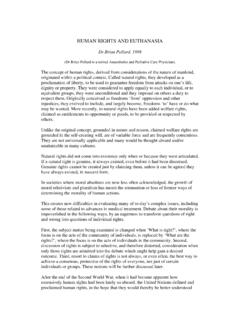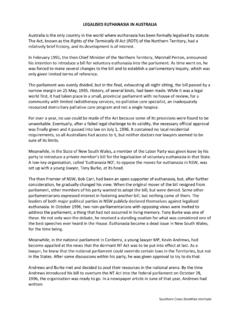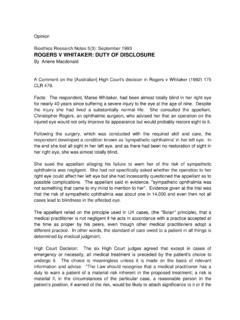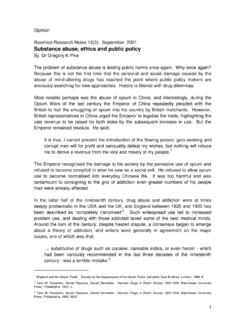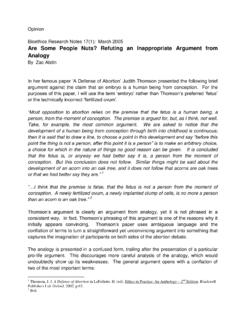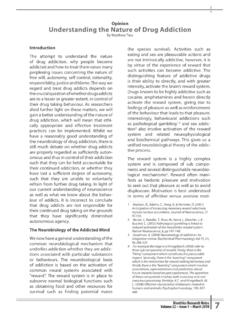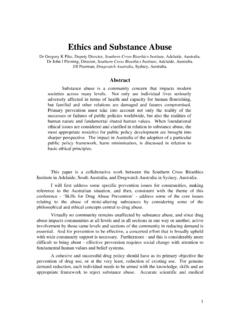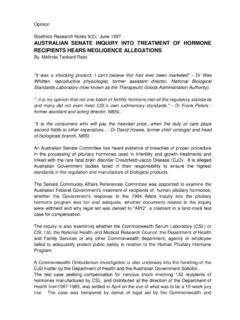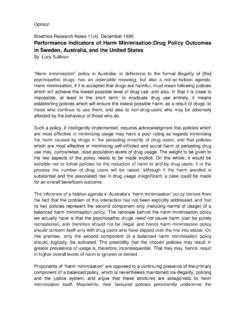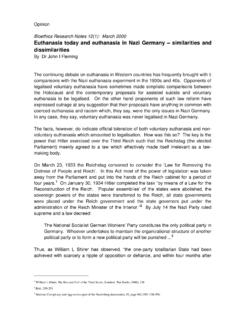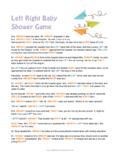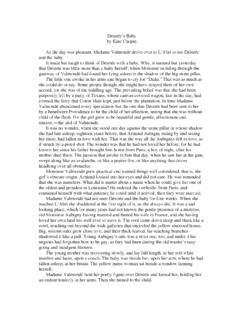Transcription of The Problem of Surrogacy - Bioethics
1 Opinion Bioethics Research Notes 19(1): March 2007 Oh baby baby : The Problem of Surrogacy By Matthew Tieu Oh baby baby , how was I supposed to know That something wasn t right here Oh baby baby , I shouldn t have let you go And now you re out of sight, yeah Show me how you want it to be Tell me baby cause I need to know now, oh because My loneliness is killing me, and I I must confess I still believe (still believe) When I m not with you I lose my (Spears, B. 1998) Introduction It is often a devastating and life changing experience for women to discover that for one reason or another they cannot become pregnant and have children of their own. In some cases, such as those involving repeated unsuccessful attempts at assisted reproductive technology (ART) or having a non-functional uterus, the remaining option (besides that of adoption) for these women and their partners is Surrogacy . However, a major concern with Surrogacy is the potential harm that may be inflicted upon the surrogate mother and the child.
2 Therefore, any legislation like South Australia s recently proposed Statutes Amendments ( Surrogacy ) Bill 2006, drafted by the Honourable John Dawkins (MLC), which would permit altruistic Surrogacy arrangements, must be considered in relation to the possibility that the commissioning couple s choices may harm the surrogate and the child she carries. Even if one were to take the liberal view that Surrogacy should be presumptively allowed on the basis of autonomy, evidence of harm must be taken seriously. In addition to the ethically problematic nature of Surrogacy in general, the Statutes Amendments ( Surrogacy ) Bill 2006 places a disproportionate burden of the terms of the Surrogacy arrangement onto a contractual agreement between surrogate and commissioning couple. In this article I will discuss a few of the major concerns in relation to Surrogacy , focusing on the importance of foetal-maternal bonding, the difficulty of a potential surrogate to give informed consent, and the contractual disputes that are likely to arise due to the logistical pitfalls of legislating for Surrogacy .
3 Furthermore, I will argue that there are good reasons, grounded in empirical evidence, to support the view that Surrogacy objectifies and subordinates the welfare of both the child and surrogate mother. Foetal Maternal Bonding Important biological bonds are established between the mother and her foetus during pregnancy. One of the most concrete examples of the importance of this bond comes from knowledge of foetal-maternal physiology. The hormone oxytocin plays a crucial role in priming the gestational mother to respond in accordance with her natural maternal instincts. In a recent review of the importance of mother-infant bonding1, the authors describe elements of the interaction between a mother and her newborn child, which include skin-to-skin contact, eye gazing, and breast-feeding. These actions initiate the simultaneous release of oxytocin, which facilitates important physiological processes that help the newborn to develop and the mother to recover.
4 In addition to providing health benefits, this hormone-like substance promotes bonding patterns and creates desire for further contact with the individuals inciting its release. 2 In addition to this biological bonding, the cognitive and developmental psychology literature indicates that there is a crucial window of time from the moment of birth onwards, whereby the baby begins to form cognitive attachments through inter-subjective interaction with the gestational mother3,4,5. Rather than living in a buzz of ambivalence or confusion as envisaged by some, an infant s behaviour is innately fashioned to coordinate with the social behaviour of other people. This is because an infant already has the cognitive mechanisms and psychological capacities in place to influence as well as be influenced by other people, and in particular his or her birth mother6. Therefore, at the very least, one ought to be especially concerned with any process that disrupts the important bond between mother and child, which derives from both biological and cognitive/psychological aspects of human nature, beginning during gestation and continuing after birth.
5 Surrogacy ruptures this bond and such is the importance of the emotional attachment between the surrogate mother and the child she has carried, that it has lead to many cases from around the world where surrogates have been unwilling to relinquish their child, such as the baby M7 and Evelyn cases8. As evidenced in these much-publicised cases, having to relinquish a child can be wrenching, the end result being custody battles. Added to this is the evidence that 1 Kennell and McGrath (2002) Starting the process of mother-infant bonding. Acta Paediatrica. 94(6):775-7 2 Palmer (2002) Bonding Matters The Chemistry of Attachment. Attachment Parenting International News. 5(2). Can be accessed online at 3 Gopnik, A & AN Meltzoff (1998) Infant cognition. In The Encyclopedia of Philosophy. Routledge 4 Meltzoff, AN & A Gopnik Op. Cit. (1993) Imitation, cultural learning and the origins of "theory of mind".
6 Commentary in Behavioral and Brain Sciences 16(3):521-522. 5 Hobson, R. Peter (2002) The Cradle of Thought: Exploring the Origins of Thinking. Macmillan: London. 6 Ibid. pg. 39. 7 Whitehead MB, Schwartz L. (1989) A Mother's Story: The Truth About the baby M Case. St Martins Pr; 1st ed. New York. 8 "Re Evelyn" [1998] Fam CA 55 (15 May 1998) surrogates may live with the psychological burden of giving up their gestational child for many years9,10,11. These matters reinforce the difficulty, if not impossibility for a surrogate mother to give informed consent. In relation to the difficulties with relinquishment, certain critical questions must be asked. What happens when there is a reluctance or refusal to stick to the original agreement? What if neither the surrogate nor the commissioning parents want the child? Should there be penalties if the agreement is not honoured? No legislation permitting Surrogacy can accommodate such complications without leading to seriously undesirable consequences, and the onus rests with those who would permit Surrogacy contracts to answer these questions adequately.
7 Furthermore, because Surrogacy results in the fragmentation of motherhood by separating the genetic, social and gestational components, the Statutes Amendments ( Surrogacy ) Bill 2006 would therefore sanction this fragmentation and devalue the importance of the foetal-maternal relationship. Contractual Disputes and Health Risks A diagnosis of disability or disease, even if equivocal, could lead to serious problems with a Surrogacy arrangement. For example, a prenatal diagnosis of disability or perceived imperfection could result in the commissioning couple reneging. At least one such case has occurred in the US12. In the case of a diagnosis of disability, depending on the circumstances and severity, the option of abortion could be considered by the surrogate; however, differing moral perspectives on abortion have the potential to result in an irresolvable stalemate. The surrogate may still wish to proceed with the birth; however, the commissioning couple may no longer want the child.
8 Alternatively, the surrogate may choose an abortion contrary to the wishes of the commissioning couple, but presumably the surrogate s decision for abortion under law would prevail. The Dawkins Bill makes no provision for such disputes, and so any burden remains with the surrogate, commissioning couple and others involved. Given that gestational Surrogacy involves ART, the health risks in ART are pertinent to Surrogacy . According to a recent review, ART is responsible for approximately 50% of all multiple births worldwide13, and about half of IVF pregnancies in the US result in multiple births, with a high risk of premature delivery14. One-third or even one-half of infant mortality is due to complications of prematurity, and a large contributor to prematurity is infertility treatment. In addition to these risks, there is a growing concern 9 Ibid. 10 Goleman, Daniel, Motivations of Surrogate Mothers, The New York Times, 20/1/1987: 11 Ciccarelli and Beckman (2005) Navigating Rough Waters: An Overview of Psychological Aspects of Surrogacy .
9 Journal of Social Issues. 61(1): 21-43. 12 Spurned baby sparks action on surrogate births The Australian, 27 January 1983; also see Singer and Wells (1984) The Re Production Revolution: New Ways of Making Babies. Note 12, 118-119 13 Gurgan T and Demirol A (2007) Unresolved issues regarding assisted reproduction technology. Reproductive Biomedicine Online. 14 Suppl 1:40-3. 14 IVF may cause higher infant death rates - More money may lead to worse health, says doctor. BioEdge 241 -- Wednesday, 21 March 2007. ( ) that other risks to children born of ART may occur. The point here is that in gestational Surrogacy , the contractual arrangement makes these problems more acute as it involves parties whose response to these issues cannot be predicted. Yet these matters have the potential to undermine the whole contract in seriously damaging ways. In a gestational Surrogacy agreement, the increased chance of multiple births could lead to contractual disputes if the intention of the commissioning couple was to have only one baby .
10 For example, a British woman pregnant with twins sued a California couple because they backed out of their Surrogacy contract after she refused to abort one of the foetuses15. There are also other significant health risks for surrogate mothers. Whilst pregnancy is natural, it is not without risk. Whereas a woman choosing to become pregnant and committed to raising her child is prepared to bear that risk, in Surrogacy , the concern is that she bears the risk without the natural benefit of motherhood. There is therefore a sense of futility if something goes wrong for her. If the Dawkins Bill is passed, it is hard to imagine how the contractual agreement between the surrogate and the commissioning couple can possibly protect either party. It appears that far too much is expected of the contractual agreement, and indeed it carries a disproportionate expectation compared to what the Bill itself provides.
